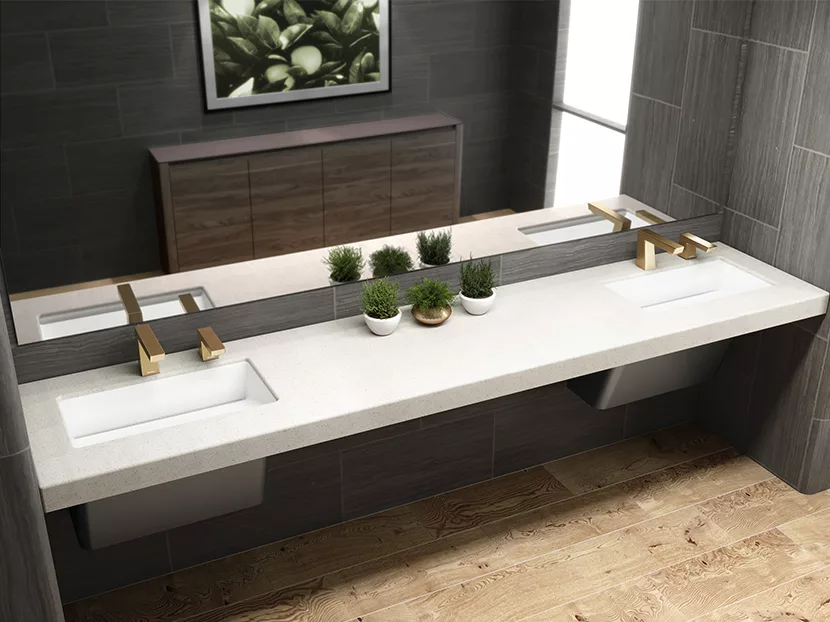The global pandemic of COVID-19 is fast-tracking infection control technologies and products in public restrooms.
“While cleanliness has always been a goal in designing restrooms, coronavirus has underscored the need for hygienic, sterile and safe environments,” said Jon Dommisse, director of strategy and corporate development, Bradley Corp., a global manufacturer of restroom equipment.
Companies, educational institutions and municipalities are all now evaluating new procedures and products for their restroom facilities.
“Businesses are looking at short-term and long-term fixes for operating safely,” said Michelle Kempen WRID, WELL AP, ASID, with Kahler Slater, a Milwaukee-based architectural firm. “The goal is to create safe and healthy indoor environments that reduce the spread of airborne and surface contaminants.”
Kempen and Dommisse identify the following design strategies to help guard against COVID-19 and other germ transmission in public restrooms:
1.No-touch fixtures
“Today’s touchless hand washing models incorporate advanced sensing technology for continuous and reliable washing,” Kempen said. “Voice command and IoT are other up-and-coming hands-free technologies for restrooms. Automatic door openers typically seen to support accessible design are now also being implemented in locations to prevent hand-surface contact.”
In fact, as schools look to re-open, guidelines like the ones issued by the Wisconsin Department of Public Instruction recommend the installation of all touch-free fixtures for infection control.
Dommisse added that the Healthy Hand Washing Survey by Bradley Corp. shows that 91 percent of Americans believe it’s important that public restrooms are equipped with touchless fixtures. “Touchless restrooms are here to stay,” he said.
2. Improved ventilation
“We are seeing clients consider using more robust HVAC systems throughout their facilities but especially in shared spaces such as in restrooms,” Kempen explained. “Ventilating with outdoor air is vital to diluting airborne contaminants.”
According to Centers for Disease Control (CDC), the coronavirus appears to spread indoors through close personal contact and via poor circulation of building ventilation systems. The American Society of Heating, Refrigerating and Air-Conditioning Engineers (ASHRAE) advises that ventilation and filtration provided by heating, ventilating, and air conditioning systems can reduce the airborne concentration of SARS-CoV-2 and thus the risk of transmission through air.
3. Modified layouts
Even before COVID-19, European restroom models with gender-neutral layouts were gaining popularity. “A parallel can be drawn between the benefits of a restroom planned to be gender-neutral and planned to address COVID-19 concerns. The European model of stalls forming a perimeter around communal washing stations with open circulation may be a layout we see more of in the U.S.,” Kempen predicted. “This design can help facilitate one-way traffic and minimize cross-traffic.”
Design elements like eliminating doors, adding S-curved and automated doors and widening doorways are also gaining traction.
4. Avoiding wet floors
Water dripping from hands onto floors can cause slips and falls, and breed bacteria, Kempen noted. To avoid wet floors, she suggests locating soap and drying options close to sinks so people needn’t move from the sink with wet hands. “I see a big opportunity for sleek all-in-one hand washing fixtures that have the soap, faucet and dryer all in one unit to contain water.”
5. Antimicrobial finishes and materials
Some high-touch restroom surfaces like grab bars are available with antimicrobial coatings. “Before COVID-19, the design community was seeing a lot of antimicrobial layers and coatings on products. We are now seeing a rise from facility managers and building owners requesting this option as an enhanced safety precaution for their customers,” Kempen said. “Clients are also considering products that are inherently antimicrobial such as copper.”
6. Sink materials and designs
“For sinks, using smooth and nonporous materials with seamless construction like solid surface and natural quartz helps prevent bacteria, mold and delamination accumulation,” Dommisse said. “For multi-user restrooms, new washbasin designs with increased space between the hand washing areas allow for social distancing while washing hands.”
While there are a number of infection control measures on the horizon for restrooms, in the short-term it’s still important to keep six feet of distance between people, wash hands with soap and water, dry hands completely, wear masks and limit crowding in restroom areas, he noted.
Bradley Corp. is a leading manufacturer of commercial plumbing fixtures, washroom accessories, restroom partitions, emergency fixtures and solid plastic lockers.





